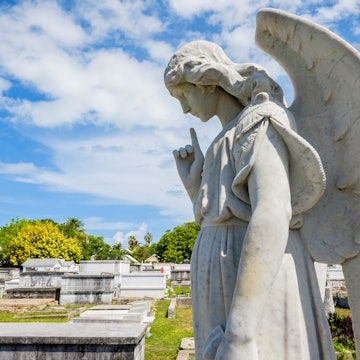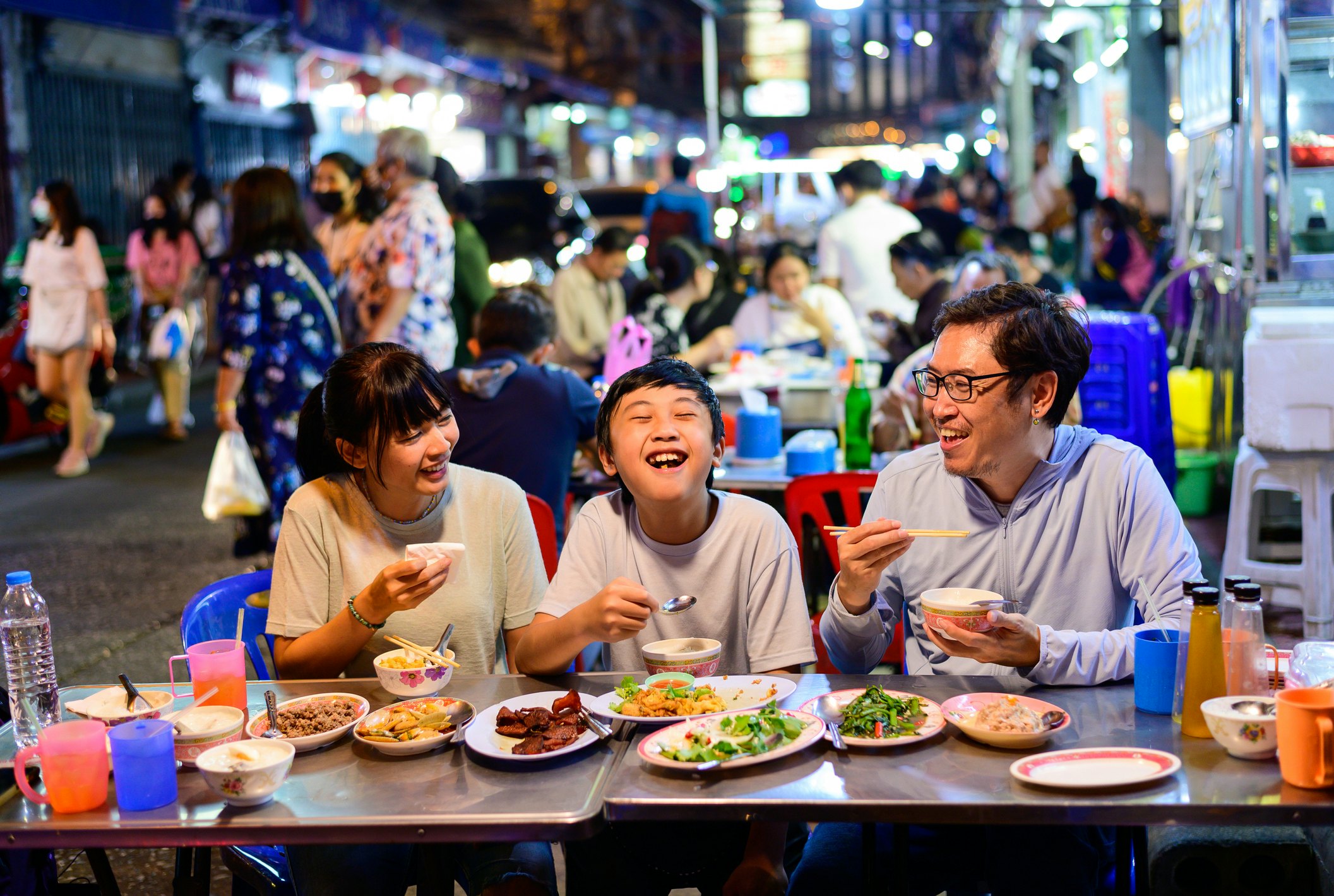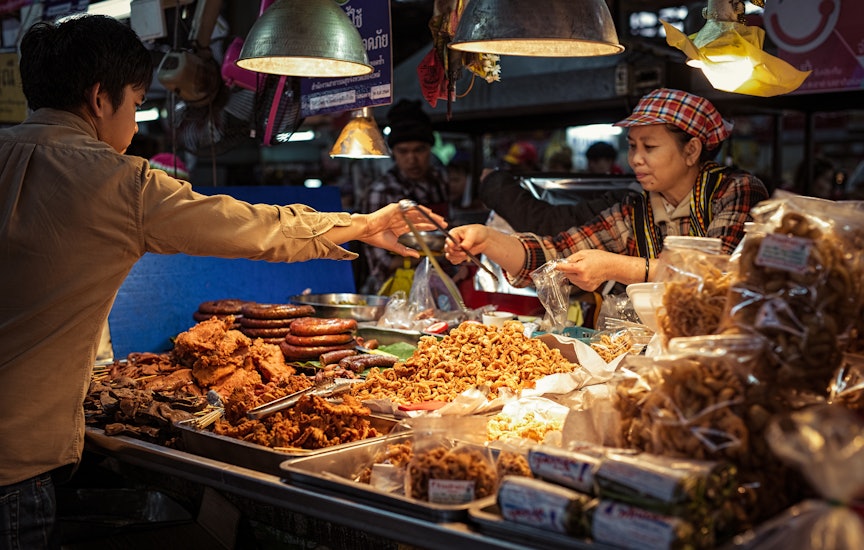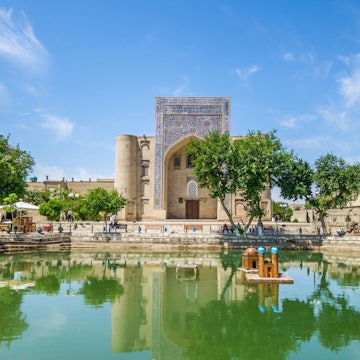

Bangkok's excellent street food and markets are a great way to eat well on a budget © Witthaya Prasongsin / Getty Images
Bangkok has an enduring allure to global visitors that never seems to get old or go out of style – it continues to fight for its spot on lists of the world's most visited cities.
From hallowed monasteries to all-night techno clubs, street noodles to Michelin-starred tasting menus, and lush public parks to gritty urban train loops, Thailand's capital will leave you dizzy with options and a never-ending list of reasons to return.
That admirable versatility creates an extreme range of costs, reflecting differing income levels and social strata amongst both locals and international visitors. The City of Angels can be a gift to budget travelers if you know where to cut corners but costs can quickly spiral if you go off script. Here are all the insider tips you need to ensure your trip to Bangkok doesn't break the bank.
Daily Costs in Bangkok
Hostel dorm bed: 250-400B
Basic room for two: 800-1500B
Self-catering apartment (including Airbnb): 800-2500B
MRT subway ticket: 15-40B
City bus: 8-25B
Canal boat: 8-20B
Motorcycle taxi: 15-100B
Car taxi: 45-200B
Coffee: 30-120B
Local Thai dinner of four dishes for two: 350-500B
Bottle of domestic beer in a shop: 41-55B
Bottle of domestic/imported beer at a bar or restaurant: 150-250B/200-270B
Glass of wine in a bar or restaurant: 150-300B
Average daily cost: 1800-2800B

Time your visit well
For maximum savings, avoid travel during peak season if at all possible. High season in Bangkok extends from mid-November to early March, when hotels, hostels and guesthouses enjoy high occupancy and charge full rates. It gets even more expensive the week before Christmas through the week after New Year's – some accommodation providers add temporary surcharges of 25 to 35 percent to their peak season rates.
Room rates tend to run significantly lower at other times of the year, with the best deals typically offered in June, July, September and October. Find out more about big events in Bangkok and what you can expect each season in our insider guide to the best times to visit.
Choose local budget airlines
Two airlines based in Thailand – Nok Air and Thai AirAsia – almost always offer lower domestic fares than those posted by national carrier Thai Airways and boutique-marketed Bangkok Airways. It also pays to travel lightly – eligible carry-ons can be taken aboard for free, while checked luggage costs 300B and up for 15kg (Thai AirAsia) or 20 kg (Nok Air). If you can't resist traveling without your home comforts, book your checked baggage in advance to save cash. Start planning early to nab the cheapest fares and choose off-season bargains to save big and stretch your budget.
Opt for a cold beer over cocktails
Wine and spirits, whether imported or produced in Thailand, are subject to high taxes – as much as 400% for imported wine. Just one bottle of wine can double or triple your restaurant tab – a night out in Bangkok that focuses on cocktails and cabernet can often cost the same as one in a European or US city. Beer, which is subject to a much lower tax rate, will bring your restaurant and bar bills down to more affordable levels.
Domestic beers such as Singha, Chang and Leo cost about 30-40% less than imported beers. International brands that are brewed in Thailand under license, such as Heineken San Miguel and Tiger, are priced in between domestic and imported beers. Thai craft beers, including such well-known brands as Chalawan, Chatri and Busaba, aren’t actually brewed in Thailand but in neighboring countries Cambodia and Vietnam, as well as in Australia; they tend to be priced similarly to imported beers.

Eat like a local
The dining scene in Bangkok has exploded over the last decade. Enterprising chefs from all over the world, along with practically every global culinary franchise, have moved in with a vengeance. At last count the city boasted 30 Michelin-starred chefs, elevating Bangkok to world-class levels for fine dining. Although these tasty delights are wonderful for a big occasional blowout, they're not a nightly option for those visiting on a budget.
Luckily, Bangkok is known for its incredible street food culture and the streets are where you'll find the best bargains. It’s also where you’ll find the most authentically Thai and Thai-Chinese cuisine, arguably representing the real heart and soul of the city. Bangkok street food includes not only umbrella-shaded carts parked at the edge of the road or on footpaths but also one-room eateries in modest shophouses throughout the city.
You'll find the pick of such culinary gems in Talat Noi, Chinatown, Suan Phlu, Phra Nakhon and Banglamphu and also in lesser numbers sprinkled about every precinct of the city. Multiple-course, family-style meals are very affordable; for tighter budgets, stick to one-plate dishes where rice is included in the order.
Embrace public transport
Taxi fares are relatively low compared to many other major global cities, but they can still eat up your daily budget quickly. The BTS Skytrain and MRT subway lines are much better budget options than taxis and you won't waste time sitting in traffic jams. The networks are quite extensive and you can reach just about any corner of the city using one or the other.
Travel cards are available for both modes of transport, but there are no discounts available and you’ll have to pay a deposit for the card. For short visits, it’s better to buy separate tickets at the station. MRT offers a 50% discount for seniors (over 60 years of age) for all fares, and you don’t have to be a Thai citizen to take advantage of the discount – just show your passport at the ticket window. A 50% discount is also available on MRT for children who are under 120cm (3.9ft) tall and aged under 14. BTS doesn’t offer senior or child fares for foreigners.
City bus fares are even cheaper than rail or subway fares, but the huge network (with over 500 separate routes) is complicated and the buses tend to be slow and relatively uncomfortable. Canal boat lines are similarly cheap but much easier to figure out. Boats run frequently in daylight hours along Khlong Saen Saep across the city from west to east, and they’re especially useful for passengers visiting attractions along the lengthy Sukhumvit Road. Hop on a motorcycle taxi from the canal jetties to get there quickly.
The Chao Phraya River Express line operates passenger boats up and down the Chao Phraya River, stopping at piers on both sides along the way for fares of between 14 to 33B. There's also a Chao Phraya Tourist Boat hop-on-hop-off service that departs every 30 minutes from 11 piers between Sathorn Pier and Phra Arthit Pier. A ticket costs 150B and includes unlimited stops along the route for one day, running from Sathorn to Phra Arthit between 9am and 7:15pm and from Phra Arthit to Sathorn between 8am and 6:30pm.

Stay outside the tourist hub
Generally speaking, restaurants and accommodations along or near Sukhumvit Rd from Soi 1 and as far east as Soi 65 tend to be more expensive than elsewhere in the city. The concentration of bars, nightclubs, restaurants, speakeasies, and massage shops in this district is significantly higher here than in any other area in Bangkok but you'll pay for the privilege.
Go beyond the tourist hub to find bargains in Talat Noi, Chinatown and Phra Nakhon (sometimes referred to as Old Town), three contiguous neighborhoods extending from Charoen Krung Rd parallel to the Chao Phraya River and then north to the Grand Palace and Wat Phra Kaew. Amidst the most historic buildings and temples in the city, there are dozens of budget hostels and guesthouses, along with small eateries and street vendors offering some of the best and most authentic Thai and Chinese cooking in the city. All for less than half the price you'd pay around Sukhumvit Rd.
The districts around Sathon and Silom Rds are a little more expensive than their Old Town neighbors but tend to be more colorful, culturally engaging and affordable than the Sukhumvit area. Towards the north end of the city, the Ari neighborhood is similarly mid-level when it comes to budget but has a more authentic Thai community vibe.
Save on sightseeing with a GetYourGuide City Card
GetYourGuide City Cards offer an all-inclusive pass good for 30+ attractions for two to five days, starting from 4500B. The card includes walking and bike tours, river cruises, cooking classes, massages, pub crawls, and a few museum entries, but not temple entry fees. Make a shortlist of your must-visit highlights to ensure you get maximum bang for your baht before booking. Why not start with our favorite 17 things to do in Bangkok?
















